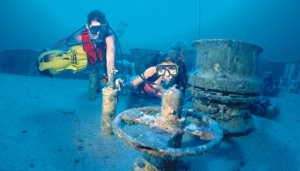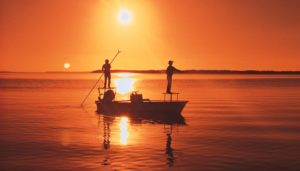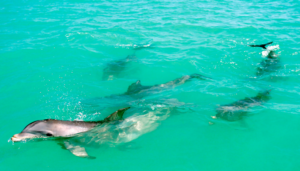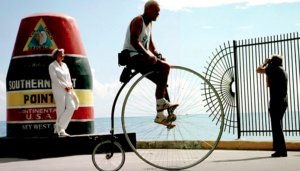Florida Keys – A necklace of islands that begins just south of Miami, the laid-back Florida Keys are connected by the Overseas Highway’s 43 bridges – one almost seven miles long – over the Atlantic Ocean and Gulf of Mexico. The area is divided into five regions: Key Largo, Islamorada, Marathon, Big Pine and the Lower Keys, and Key West. Each has its own flavor, attractions including historic museums, flora, fauna, seafood restaurants, fishing, diving, watersports and boutique-type shopping. Vistas of the Keys feature deep-blue seas, nodding palms and olive-green mangroves. Sharing this eco-paradise are white herons, roseate spoonbills, pelicans, sea gulls, ospreys and countless underwater creatures. The coastal waters of the entire 125-mile island chain, which is paralleled by North America’s only living coral barrier reef, have been designated the Florida Keys National Marine Sanctuary.
• A drive across the new Seven Mile Bridge, the longest segmental bridge in the world, Marathon Key
• Drive the Keys on the All-American Road
• John Pennekamp Coral Reef State Park (snorkeling or glass bottom boat) Key Largo
• Have your photo taken in front of the giant Lobster at the Rain Barrel Islamorada
• Feed the tarpon at Robbie’s Marina, MM 79, Islamorada
• Tour the Dolphin Research Center Marathon
• Swim, sunbathe and explore Bahia Honda State Park Lower Keys
• Visit the Ernest Hemingway Home and Museum, Key West
• Ride the Conch Train or Trolley Tour in Key West
• Experience the Sunset Celebration at mallory Square in Key West
• Tour on the African Queen, Key Largo
• Kayak or paddle boards the flats in Islamorada
• Visit historic Pigeon Key, Marathon
• Visit the Turtle Hospital in Marathon
• Discover the Key Deer Refuge, Lower Keys
• Hire a backcountry guide out of Sugarloaf Marina and explore dolphins, turtles and other marind and bird life in the Great White Heron National Refuge (15 miles north of Key West)
• Experience the Key West Butterfly and Nature Conservatory, Key West
• Take a Sunset Cruise in Key West
• Explore America’s most remote national park, the Dry Tortugas, either by passenger

The longest island in the Keys, Key Largo gave its name to the movie classic starring Humphrey Bogart and Lauren Bacall — portions of which were filmed there. Visitors also can see the African Queen, the actual boat Bogart skippered in the movie of the same name.
But Key Largo’s star attraction is John Pennekamp Coral Reef State Park — the first underwater preserve in the United States — that is incorporated within the Florida Keys National Marine Sanctuary. These protected areas feature 55 varieties of delicate corals and more than 600 different species of fish.
Pennekamp Park offers a variety of water-related activities including scuba, snorkeling and glass-bottom boat excursions to the coral reef. Key Largo also boasts a number of off-park dive charter companies that conduct dive sojourns — and a few even feature underwater weddings.
Key Largo also is home to the Spiegel Grove, a retired U.S. Navy ship that is one of the largest vessels in the world ever purposely scuttled to create an artificial reef.

Islamorada is the centerpiece of a group of islands called the “purple isles.” Legend says Spanish explorers named the area from “morado,” the Spanish word for purple — either for the violet sea snail or purple bougainvillea flowers found there.
Known as the Sport-Fishing Capital of the World, Islamorada is heralded for its angling diversity and features the Keys’ largest fleet of offshore charter boats and shallow-water “backcountry” boats.Numerous celebrities visit Islamorada annually to compete in a number of acclaimed fund-raising fishing tournaments.
The Keys boast more sport-fishing world records than any other fishing destination in the world, according to the International Game Fish Association. Anglers can find sailfish, marlin, dolphin (the fish, not the mammal), kingfish, snapper, barracuda and grouper in the ocean. Tarpon, bonefish, redfish and other species can be found in shallow coastal waters.

Home to the Seven Mile Bridge, Marathon is centrally located between Key Largo and Key West. Attractions include the 63.5-acre Crane Point, an important historical and archaeological site, and the Dolphin Research Center, one of numerous Keys facilities that provide visitors an opportunity to swim and interact with the intelligent mammals.
Reservations for the dolphin encounter programs at Dolphin Research Center and other facilities — including Dolphins Plus and Dolphin Cove in Key Largo, Theater of the Sea in Islamorada and Hawk’s Cay Resort — must be made in advance, and the interactions are governed by strict guidelines.
A drive across the new Seven Mile Bridge (actually 6.79 miles long), the longest segmental bridge in the world, leads to the Lower Keys. Visitors can explore Pigeon Key, a small island below the middle of the old Seven Mile Bridge, that is accessible from a visitor center at Marathon’s west end. Pigeon Key housed workers who built Henry Flagler’s railroad in the early 1900s, and it’s now a national historic treasure with a museum chronicling the construction of the Seven Mile Bridge.

The sheer sweep of the Straits of Florida and the Gulf of Mexico is readily seen from the Bahia Honda Bridge. Bahia Honda State Park, whose beach was named one of the top 10 in the United States by several travel studies, is a prime example of the Lower Keys’ pristine beauty.
The Lower Keys are noted for Looe Key Reef, rated by many as among the most spectacular shallow-water dive experiences to be found. Just to the west of Looe Key, the 210-foot island freighter Adolphus Busch Senior rests on the bottom of the ocean as an artificial reef.
Big Pine Key also features a national refuge for miniature Key deer, tropical forest and even a few alligators. Popular nature tours, many by kayak, offer unforgettable opportunities to view the unique flora and fauna of this area of the Keys.

The final stop on the Overseas Highway, Key West features 19th-century charm and contemporary attractions. Continental America’s southernmost city, situated closer to Cuba than Miami, it includes quaint, palm-lined streets, century-old gingerbread mansions and a laid-back citizenry.
This small, 2-by-4-mile island features a lively artistic community, with numerous galleries exhibiting fine art and artisan crafts, and has nurtured literally scores of published author/residents. Novelist Ernest Hemingway lived in Key West throughout the 1930s, writing masterpieces including “For Whom the Bell Tolls” and “To Have and Have Not.” His former residence is now a public museum.
Key West also is home to other treasures. The late shipwreck salvager Mel Fisher, a longtime resident, recovered more than $400 million in gold and silver from the 17th-century Spanish galleon Nuestra Señora de Atocha that sank 45 miles west of Key West. At the Mel Fisher Maritime Museum, visitors can discover the riches of the Atocha and other area shipwrecks.
At day’s end in Key West, crowds gather at Mallory Square to experience the nightly “sunset celebration.” While musicians, jugglers, mimes and other performers provide entertainment, the sun sinks slowly below the horizon as sunset cruise boats sail by in Key West Harbor.
Dining opportunities in the island city are as enticing as the sunset. Cuisine choices include succulent area seafood such as shrimp, Florida lobster, conch chowder, local fish and stone crab claws. Key lime pie is a heavenly end to an exquisite meal.

Arizona Holidays. was established in 1997 by Mr. Manish Shah. It was his vision to provide the Indian traveler with Superior quality package tour facilities.